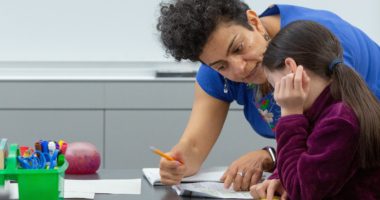Between the Echoes: ‘We Are Still Here’ — Native Students and Postsecondary Dreams
An offshoot of Ed Trust’s Echoes From the Gap series, drawing stories of students from behind the statistics, this blog series shares shorter narratives — brief glimpses into classrooms and hallways — that give readers an opportunity to examine educator practices and policies through the intimate lens of student experience. All stories are based on interviews or first-hand accounts, but are shared with respect for the privacy of students and the adults around them.
They came from reservations across the state, in cars carefully packed with younger siblings and elders; in rusted-out church and community center buses, excited faces plastered to dusty windows taking in the world off the rez. They came with aunties and mothers, uncles and grandpas, big sisters and mentors, favorite pillows and PJs. For many, it would be their first time on a college campus; for more than a few, their first time off the reservation.
They were participating in a weeklong summer program, part of a state’s efforts to foster postsecondary aspirations and success among Native youth through a combination of educational, cultural, and social enrichment.
The data that chart the trajectories of Native students through educational systems built on their ancestors’ land are hard to look at. Over half of all Native fourth-graders in America perform at below basic levels in reading. Forty-six percent of eighth-graders fall below basic in math. By 12th grade, of those who remain in school, over a third perform below basic in reading.
The four-year high school graduation rate for Native youth is 69 percent. But, even among Native graduates, only one in four who took the ACT scored at the college-ready level in math, and one-third in reading. And of those who enroll in a four-year college, only 39 percent complete a bachelor’s degree in six years.
In fact, the data for this population of young people are so dismal — and their numbers so small — that oftentimes they’re not even included, as if there’s so little hope, they drop like tears off our bar charts and data dashboards.
But a week with this group of students at this summer program nearly 16 hours a day and all I saw was hope. And promise. And resilience. And heart.
As I write, I hear their names and voices in my head. But I will use simple pronouns here, for privacy’s sake.
…He is a writer and rapper, saved from his self-described “dark path” by the messages from Bone Thugs-n-Harmony and other artists who — across racial and reservation lines — spoke to his experience, hardships, and hopes. Wants to use his music to speak to Native youth who are struggling.
…She is an aspiring psychologist. Knows all too well the need for culturally aware and responsive mental health and family supports for Native young people on reservations. Works hard and keeps her grades up but struggles with her mostly white teachers who she believes don’t think she can get there.
…He is an artist, struggling to fight his demons and communicate to the world through skilled hands, a mechanical pencil, and sketch pad and find something beyond the margins of his story. Spent much of the week hidden behind the hair he let fall over his face, but by Friday stood at a podium and spoke in front of his peers.
…She is an aspiring lawyer and proud Sioux. Will be the first in her family through high school and will receive her Indian name after graduation. Dreams of claiming a space in the courtroom to fight for her people’s rights and sovereignty.
…And then the budding young leader, unbound by gender, undaunted by obstacles, genuine, and funny as heck. Wants to become a veterinarian and take care of all of the rez dogs that go hungry and without shelter. A gentle protector who could also hold it down like no one was watching doing the Cupid Shuffle on a dance floor full of giggling girls.
Each student vivid, visible, and unique.
Among these young people and their peers, 27 in total, there was no lack of dreaming, no shortage of aspiration. They wrote pages in journals, dreams in vivid detail, with no hesitation, prodding, or cajoling.
But a show of hands on how many knew what they needed to do to get there made clear that what these young people lacked was real guidance on how to get from where they were to where they wanted to go. When asked whether there was someone at their school from whom they could get information and advice on how to achieve their goals, just two hands raised.
Two of 27. That is the data point that is perhaps more daunting — and more telling — than any about what needs to happen to turn results, and lives, around.
And not just for 27 students for a week over the summer, but for their thousands of peers elsewhere, and throughout the year.
In even the most barren of educational landscapes, these young people have managed to keep a fire stoked beneath their dreams. They want America to know, as one young person in the group proclaimed, that they “are still here.”
That they are not in need of fire, but of kindling.
Not lacking for dreams, but for real guidance.
Not tears soaked into the X axis of America’s achievement, but hopes springing from it.











